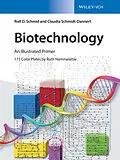Now presented in large format, the new Schmid is the ideal primer in biotechnology. The two-page layout with one page being a full color figure and the opposite page being explanatory text is the ideal combination between rapid visual-based learning with in depth information.
Autorentext
Rolf Schmid studied chemistry, biochemistry and microbiology in Munich and Freiburg (Germany). After postdoctoral training in Gif-sur-Yvette (France) and Austin (USA), he joined Henkel KGaA in Dusseldorf (Germany) where he worked for 15 years, eventually as Director R&D Biotechnology. In 1987, he was invited to direct the Institute for Enzyme Technology at Braunschweig Technical University and the Division of Enzyme Technology and Chemistry of Natural Products at the 'Gesellschaft fur biotechnologische Forschung' (GBF) in Braunschweig (Germany). From 1993 to 2009, he was Director of the Institute for Enzyme Technology at Stuttgart University (Germany). After having obtained an MBA diploma from the University of Reutlingen in 2007, he founded the consulting agency www.bio4business.eu in Stuttgart, followed in 2015 by the Steinbeis Consulting Agency www.asia-tech.eu.
Dr. Claudia Schmidt-Dannert is Distinguished McKnight Professor in the Department of Biochemistry, Molecular Biology and Biophysics, at the University of Minnesota (USA). She studied Biology and Biochemistry at the Carolo Wilhelmina University Braunschweig (Germany), where she received her Ph.D. in Biochemistry in 1994. Schmidt-Dannert held a Postdoc position in Molecular Biotechnology at the University of Stuttgart (Germany) and became Professor at the University of Minnesota in 2010. Her research focuses on exploring and utilizing the metabolic machineries of plants and microorganisms to enable the discovery and synthesis of valuable microbial or plant-derived compounds in engineered microbial cells.
Inhalt
Preface ix
Preface to the 2nd Edition x
Introduction 1
Introduction
Early developments 2
Biotechnology today 4
Gene cloning and identification 60
Gene expression 62
Gene silencing 64
Epigenetics 66
Gene libraries and gene mapping 68
Genetic maps of prokaryotes 70
Genetic maps of eukaryotes 72
Metagenomics 74
Microbiology
Viruses 6
Bacteriophages 8
Microorganisms 10
Bacteria 12
Yeasts 14
Fungi 16
Algae 18
Some bacteria of importance for biotechnology 20
Microorganisms: isolation, preservation, safety 22
Microorganisms: strain improvement 24
Biochemistry
Biochemistry 26
Amino acids, peptides, proteins 28
Enzymes: structure, function, kinetics 30
Sugars, glycosides, oligo- and polysaccharides 32
Lipids, membranes, membrane proteins 34
Metabolism 36
Genetic engineering
DNA: structure 38
DNA: function 40
Rna 42
Genetic engineering: general steps 44
Preparation of DNA 46
Other useful enzymes for DNA manipulation 48
PCR: general method 50
PCR: laboratory methods 52
DNA: synthesis and size determination 54
DNA sequencing 56
Transfer of foreign DNA in living cells (transformation) 58
Cell biology
Cell biology 76
Stem cells 78
Blood cells and immune system 80
Antibodies 82
Reporter groups 84
Solid state fermentation (SSF) 86
Growing microorganisms 88
Growth kinetics and product formation 90
Fed-batch, continuous and high cell density fermentation 92
Fermentation technology 94
Fermentation technology: scale-up 96
Cultivation of mammalian cells 98
Mammalian cell bioreactors 100
Enzyme and cell reactors 102
Recovery of bioproducts 104
Recovery of proteins: chromatography 106
Economic aspects of industrial processes 108
Food and food additives
Alcoholic beverages 110
Beer 112
Fermented food 114
Food and lactic acid fermentation 116
Prebiotics and probiotics 118
Bakers' yeast and fodder yeasts 120
Fodder yeasts from petroleum feedstocks, single cell oil 122
Amino acids 124
l-Glutamic acid 126
d,l-Methionine, l-lysine, and l-threonine 128
Aspartame™, l-phenylalanine, and l-aspartic acid 130
Amino acids via enzymatic transformation 132
Vitamins 134
Industrial products
Bio-Ethanol 138
1-Butanol 140
Higher alcohols and alkenes 142
Acetic acid / vinegar 144
Citric acid 146
Lactic acid, 3-hydroxy-propionic acid (3-hp) 148
Gluconic acid and green sugar chemicals 150
Dicarboxylic acids 152
Biopolymers: Polyesters 154
Biopolymers: Polyamides 156
Polysaccharides 158
Biosurfactants 160
Fatty acids and their esters 162
Enzyme technology
Biotransformation 164
Technical enzymes 166
Applied enzyme catalysis 168
Regio- and enantioselective enzymatic synthesis 170
Enzymes as processing aids 172
Detergent enzymes 174
Enzymes for starch hydrolysis 176
Enzymatic starch hydrolysis 178
Enzymes and sweeteners 180
Enzymes for the hydrolysis of cellulose and polyoses 182
Enzymes in pulp and paper processing 184
Pectinases 186
Enzymes and milk products 188
...